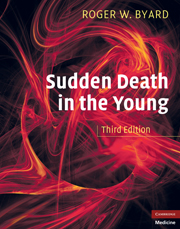Book contents
- Frontmatter
- Contents
- Preface to the third edition
- Reviews of the first and second editions
- Acknowledgments
- Section 1 Introduction
- Section 2 Unintentional trauma
- Section 3 International trauma
- Section 4 Natural disease
- 4 Infectious conditions
- 5 Cardiac conditions
- 6 Vascular conditions
- 7 Respiratory conditions
- 8 Neurological conditions
- 9 Hematological conditions
- 10 Gastrointestinal and genitourinary conditions
- 11 Metabolic and endocrine conditions
- 12 Miscellaneous conditions
- Section 5 Maternal, fetal, and neonatal conditions
- Section 6 Sudden infant death syndrome
- Appendices
- Index
11 - Metabolic and endocrine conditions
from Section 4 - Natural disease
Published online by Cambridge University Press: 05 January 2013
- Frontmatter
- Contents
- Preface to the third edition
- Reviews of the first and second editions
- Acknowledgments
- Section 1 Introduction
- Section 2 Unintentional trauma
- Section 3 International trauma
- Section 4 Natural disease
- 4 Infectious conditions
- 5 Cardiac conditions
- 6 Vascular conditions
- 7 Respiratory conditions
- 8 Neurological conditions
- 9 Hematological conditions
- 10 Gastrointestinal and genitourinary conditions
- 11 Metabolic and endocrine conditions
- 12 Miscellaneous conditions
- Section 5 Maternal, fetal, and neonatal conditions
- Section 6 Sudden infant death syndrome
- Appendices
- Index
Summary
METABOLIC DISORDERS
A range of inborn errors of metabolism may cause unexpected death in the young most often from seizures, acute encephalopathy, and cardiac disease (Table 11.1). Other clinical presentations in infants and children include failure to thrive, hypotonia, psychomotor delay, unusual odors, vomiting, and diarrhea, sometimes with a family history of an inherited metabolic disorder or previous infant or childhood deaths. Inheritance is usually autosomal recessive or X-linked. As inborn errors of metabolism represent a very heterogeneous group of over 400 disorders, only the more “common” conditions are dealt with in detail in this text; acquired metabolic disorders are also included. The diagnosis of a metabolic disorder is more likely to be known in older children and adolescents than in infants, and so the autopsy may assume particular importance in establishing the diagnosis in very early life. Occasional cases may remain undiagnosed until adult life. Features in the presenting history that may suggest certain disorders are listed in Table 11.2 and an approach to the autopsy in suspected metabolic disorders is outlined in Table 11.3.
Frequency
The estimated frequency of metabolic disease in infants dying suddenly and unexpectedly has been controversial, with some authors claiming that between 5% and 20% of cases result from metabolic defects. However, these high figures do not appear to reflect general experience.
- Type
- Chapter
- Information
- Sudden Death in the Young , pp. 463 - 490Publisher: Cambridge University PressPrint publication year: 2010



